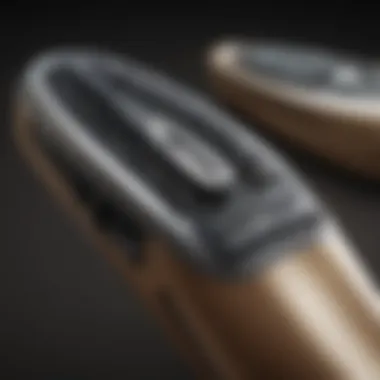Mastering Ingrown Hair Management: Effective Strategies


Intro
Ingrown hairs are a common skin condition that results when hair grows back into the skin instead of outward. This can cause discomfort, irritation, and even infection in some cases. Understanding the factors that contribute to ingrown hairs is essential for both prevention and treatment. Factors may include hair removal methods, skin type, and personal hygiene practices.
Knowledge of effective strategies to manage these issues can greatly improve skin health and overall comfort. In this article, we will delve into various techniques and approaches that can help individuals address ingrown hairs. This includes discussing hygiene practices, appropriate hair removal techniques, skin care routines, and available medicinal interventions.
Effective management starts with understanding the role of proper skin care and hair removal techniques. Often, people overlook the importance of using the right products or methods, which can lead to unwanted complications. By taking the time to educate oneself on these aspects, individuals can not only diminish the occurrence of ingrown hairs but also enhance their overall well-being.
Understanding Ingrown Hairs
Understanding ingrown hairs is essential for individuals seeking to maintain optimal skin health and appearance. Ingrown hairs occur when hair grows back into the skin instead of emerging from the follicle. This condition can lead to irritation, inflammation, and sometimes infection. By understanding the mechanics of ingrown hairs, their common causes, and prevention strategies, individuals can reduce discomfort and improve their skin's overall aesthetics.
Definition and Overview
Ingrown hairs are defined as hairs that, instead of growing out through the skin, curl back and penetrate it. This phenomenon can occur in various parts of the body but is particularly common after shaving or waxing. The skin surrounding the hair can become red, itchy, and sometimes painful. Individuals may notice small bumps that resemble pimples, which can be confused with other skin conditions. Recognizing ingrown hairs is vital for effective management, as early intervention reduces the risk of complications such as scarring or infection.
Common Areas Affected
Certain areas of the body are more prone to developing ingrown hairs.
- Facial Area: Men often experience ingrown hairs in the beard area due to shaving.
- Neck: Both men and women may notice ingrown hairs in this region after improper shaving techniques.
- Armpits: Shaving in this sensitive area can lead to ingrown hairs.
- Bikini Line: Women often face ingrown hairs here due to hair removal methods.
- Legs: Shaving can create a favorable environment for ingrown hairs on legs as well.
By being aware of these common areas, individuals can take steps to prevent ingrown hairs where they are most likely to occur.
Causes of Ingrown Hairs
Several factors contribute to the development of ingrown hairs. Understanding these causes can aid in prevention efforts.
- Improper Shaving Techniques: Shaving too closely or using dull razors can result in hair curling back into the skin.
- Body Hair Texture: Curly or coarse hair is more likely to become ingrown due to the shape of the hair strand.
- Skin Conditions: Affected skin can exacerbate the problem, particularly in cases where the skin is dry or flaky.
- Tight Clothing: Wearing tight clothing, particularly after shaving, can cause hairs to grow back improperly.
- Hormonal Changes: Hormonal fluctuations can impact hair texture and growth patterns, increasing the likelihood of ingrown hairs.
Understanding these causes is the first step in preventing ingrown hairs effectively. Addressing these factors can lead to long-term improvements in skin health and comfort.
Preventive Measures
Preventive measures play a crucial role in the management of ingrown hairs. By adopting effective strategies, individuals can minimize the occurrence of ingrown hairs, which often lead to discomfort and cosmetic concerns. Understanding preventive measures not only aids in maintaining skin health but also enhances the overall hygiene and grooming routines. Emphasizing prevention can lead to longer-term benefits such as smoother skin and reduced irritation.
Exfoliation Techniques
Exfoliation is vital in preventing ingrown hairs. It removes dead skin cells that can clog hair follicles, thus preventing hairs from growing into the skin. Regular exfoliation can be achieved using various methods:
- Physical Exfoliation: This involves using scrubs or brushes. Products containing small granules or textured cloths aid in the removal of dead skin. It's important to be gentle; harsh scrubbing can irritate the skin.
- Chemical Exfoliation: Products with alpha-hydroxy acids or beta-hydroxy acids can help by dissolving dead skin cells. They are often less abrasive compared to physical exfoliants.
- Frequency: Exfoliating two to three times a week is typically sufficient. Excessive exfoliation can damage the skin barrier and cause irritation.
Proper Shaving Methods
Proper shaving techniques are essential for minimizing the risk of ingrown hairs. Here are key strategies to consider:


- Preparation: Always prepare the skin before shaving. This can include taking a warm shower or applying a warm towel to soften hair and open pores.
- Shaving Creams: Use a quality shaving cream or gel. This helps in lubrication, making the shaving process smoother and reducing friction on the skin.
- Shaving Direction: It is advisable to shave in the direction of hair growth. Shaving against the grain can lead to sharper hair edges that are more likely to become ingrown.
- Razor Maintenance: Using a clean and sharp razor is critical. Dull blades can tug at the hair instead of cutting it cleanly, leading to ingrown hairs.
Use of Hair Removal Creams
Hair removal creams can be an alternative to shaving and other methods. Here are important considerations:
- Select Suitable Products: Not all creams are suitable for every skin type. Choose products that suit your specific needs and skin sensitivities.
- Patch Testing: Before use, conduct a patch test to avoid allergic reactions. Apply a small amount and wait for 24 hours to observe any adverse effects.
- Follow Instructions: Adhere to the usage instructions carefully. Overuse or improper application can lead to skin damage and irritation.
Choosing the Right Tools
The selection of appropriate grooming tools is crucial for preventing ingrown hairs:
- Razor Type: Opt for razors with multiple blades, but be cautious. More blades can sometimes lead to a closer shave, increasing the risk of ingrown hairs.
- Tweezers and Comedone Extractors: If tweezing is necessary, ensure the tools are clean. They should also be properly sterilized to avoid infection.
- Electric Shavers: Some may find electric shavers less likely to cause irritation compared to traditional razors. They can be a suitable option for sensitive skin.
Proper grooming tools and techniques can make a significant difference in preventing ingrown hairs.
Hygiene Practices
Maintaining proper hygiene practices is essential in managing ingrown hairs. Neglecting skin hygiene can exacerbate the irritation caused by ingrown hairs and may lead to further complications such as infections. By prioritizing clean skin, individuals can significantly reduce the likelihood of experiencing these discomforting issues. Regular cleansing and care are key components of a successful skin management routine.
Daily Skin Care Routine
A daily skin care routine serves as the foundation for preventing ingrown hairs. It involves several basic steps that promote healthy skin while minimizing the risk of hair becoming trapped beneath the skin surface. Here are some effective practices to consider:
- Gentle Cleansing: Begin with gentle cleansers that do not strip the skin of its natural oils. Use a product that suits your skin type to avoid irritation.
- Exfoliation: Exfoliate the skin regularly to slough off dead skin cells that can block hair follicles. Consider chemical exfoliants with alpha-hydroxy acids or beta-hydroxy acids for optimal results.
- Moisturizing: Hydrating the skin is crucial. Use a lightweight moisturizer to keep the skin supple and less prone to irritation.
- Sun Protection: Always apply sunscreen to protect the skin from UV damage, as sunburn can lead to dryness and increase the risk of ingrown hairs.
Incorporating these steps can lead to improved skin condition and a reduction in the occurrence of ingrown hairs.
Importance of Cleanliness
Cleanliness is another vital aspect of managing ingrown hairs. Keeping the skin free from dirt, oil, and bacteria directly impacts the health of hair follicles. Here are a few reasons why cleanliness is essential:
- Preventing Infections: Dirt and bacteria can worsen ingrown hairs, possibly leading to infections. Ensuring the skin is clean helps in minimizing this risk.
- Reducing Irritation: Clean skin is less likely to become irritated. This reduces redness, swelling, and discomfort associated with ingrown hairs.
- Promoting Hair Growth: A clean environment allows the hair to grow freely without obstruction. This is particularly important during the hair regrowth phase after shaving or waxing.
By adhering to proper cleanliness protocols, individuals can cultivate a healthier skin environment, thus significantly reducing the chances of encountering ingrown hairs.
Treatment Options
The subject of treatment options is essential when addressing ingrown hairs. These methods can alleviate discomfort, improve appearance, and prevent further occurrences. It is not enough to only focus on prevention; understanding how to treat ingrown hairs effectively can lead to better skin health and overall satisfaction. Various treatment strategies exist, and knowing the distinctions among them can enable individuals to make informed choices tailored to their skin types and specific conditions.
Topical Treatments
Topical treatments often serve as the first line of defense against ingrown hairs. These products can provide targeted relief directly to the affected areas. Common topical treatments include creams and gels designed to reduce inflammation and irritation.
- Hydrocortisone Cream can decrease swelling and redness by promoting healing.
- Exfoliating Scrubs containing alpha-hydroxy acids or salicylic acid can help by sloughing off dead skin cells, unclogging pores, and allowing hairs to grow out properly.
- Antibiotic Ointments are useful if there is evidence of infection. They help to eliminate bacteria and promote healing in the affected area.
While these treatments can be useful, it is critical to follow instructions carefully to avoid skin irritation. Consulting with a dermatologist before starting any new treatment is advisable to ensure it aligns with individual skin needs.


Oral Medications
In certain circumstances, oral medications may be necessary. These options are typically considered when topical treatments do not yield satisfactory results. They have specific benefits and should be used under medical supervision.
- Antibiotics can be prescribed for infections resulting from ingrown hairs. They help combat bacteria and reduce the risk of spreading infection, especially in cases where inflammation is severe.
- Anti-inflammatory Drugs, like ibuprofen, can reduce pain and swelling associated with ingrown hairs. While they do not directly treat the underlying issue, they alleviate discomfort during the healing process.
Before seeking oral medications for ingrown hairs, it is wise to discuss potential side effects and interactions with a healthcare provider.
Professional Interventions
For persistent cases of ingrown hairs or severe irritation, professional interventions may be the most effective course of action. Dermatologists can provide specialized treatments that are not accessible through over-the-counter products.
- Lancing Procedures: In this method, the dermatologist makes a small incision to release the ingrown hair. This can alleviate pain and promote faster healing.
- Laser Hair Removal: This option reduces hair growth in targeted areas over time, significantly reducing the chance of developing ingrown hairs.
- Chemical Peels: These treatments can deeply exfoliate the skin to address clogged pores and promote smoother hair growth patterns.
Seeking professional help can often lead to effective and long-lasting solutions for stubborn ingrown hairs.
These treatment options provide a comprehensive approach for managing ingrown hairs. By understanding what is available, individuals can better address their skin concerns and develop a balanced strategy for relief.
Home Remedies
Home remedies play a significant role in managing ingrown hairs. These approaches offer accessible, cost-effective options that many individuals can implement easily at home. The primary benefit of using home remedies is that they often utilize natural ingredients that are less likely to cause irritation compared to commercial products. Furthermore, these remedies can actively promote healing and soothe discomfort, making them an appealing choice for those dealing with the aftermath of ingrown hairs.
The strategies under the umbrella of home remedies largely aim to alleviate pain and reduce inflammation. Natural solutions also present a holistic approach, where the focus is on improving skin health as a whole. It is essential, however, to consider individual sensitivities to certain ingredients. Testing a small amount on the skin before applying widely can help avoid adverse reactions.
Natural Exfoliants
Natural exfoliants serve as a foundation for enhancing skin health and preventing ingrown hairs. These products help remove dead skin cells, which can clog hair follicles and trap hairs beneath the skin's surface. Effective natural exfoliants include ingredients like sugar, salt, and oatmeal, which can be combined with oils such as coconut or olive oil to create a gentle scrub.
- Sugar Scrub: Mixing granulated sugar with a carrier oil forms a simple yet effective exfoliant. Rub gently in circular motions on affected areas three times a week to encourage hair to grow out.
- Oatmeal Paste: Oatmeal can soothe inflamed skin. Combine ground oatmeal with water to form a paste. Apply it as a mask, leave it on for 10 to 15 minutes, and rinse off with lukewarm water.
Using these natural exfoliants can significantly enhance the skin's surface texture and reduce the occurrence of ingrown hairs if applied regularly. However, moderation is key. Over-exfoliation can lead to irritation and further problems.
Soothing Compresses
Soothing compresses are another effective method to alleviate the symptoms associated with ingrown hairs. These can provide immediate relief from pain and inflammation while encouraging the healing process. Compresses can be made from various ingredients, including chamomile tea bags, aloe vera gel, or even raw honey. These elements have anti-inflammatory properties, which are particularly beneficial for irritated skin.
- Chamomile Compress: Steep chamomile tea bags in hot water, then cool them down. Place the cooled tea bags on the affected area for about 10 to 15 minutes. This can reduce redness and calm the skin.
- Aloe Vera Gel: Applying pure aloe vera gel to the skin can help soothe inflammation and promote healing. It can be left on as a leave-in treatment or rinsed off after 30 minutes.
Using soothing compresses regularly can lead to improved comfort and skin health. They can be particularly useful following hair removal practices that may cause irritation or are prone to ingrown hairs.
By incorporating these home remedies into your self-care routine, you may improve your overall skin health and effectively manage the discomfort associated with ingrown hairs.
Long-term Management Strategies
Long-term management strategies are crucial in combating the issue of ingrown hairs. Adopting consistent practices not only minimizes the risk of future occurrences but also enhances overall skin health. These strategies require dedication and attention to skin care but yield significant benefits.


Regular Skin Assessments
Regular skin assessments can help in identifying any abnormalities early on. This practice involves observing the skin for signs of ingrown hairs or irritation. Keeping a schedule for skin checks can be effective. A monthly assessment allows individuals to notice any emerging hairs that have the potential to become ingrown. Additionally, tracking changes in skin texture and tone can inform if certain products are working well or causing irritation.
- Look for redness or inflammation: Early detection is key.
- Check for bumps or unusual growths: These can be indicators of ingrown hairs.
- Record findings: Keeping a journal can help recognize patterns in skin behavior.
Regular monitoring implies being attentive to one's skin. This vigilance can make a significant difference in managing ingrown hairs in the long run.
Adaptation of New Techniques
Adopting new techniques is essential for effective long-term management of ingrown hairs. The landscape of skin care is continually evolving. Therefore, being open to adjusting routines can lead to better outcomes. Some techniques that may prove useful include:
- Updated shaving practices: Using techniques that are less likely to irritate the skin can greatly reduce ingrown hairs.
- Alternative hair removal methods: Laser hair removal, for instance, is gaining popularity. It can provide longer-lasting smoothness and minimize the risk of ingrown hairs.
- Incorporating technology: Devices like electric shavers or epilators can help in improving hair removal efficacy while reducing skin irritation.
Tracking the effectiveness of new methods is equally important. Keeping an open mind while evaluating what works is vital.
"Continual learning and adaptation are key; what works can change as skin ages and responds to various treatments."
Long-term strategies, centered on regular skin assessments and the willingness to adapt new techniques, are vital for anyone looking to manage ingrown hairs effectively. By embracing these approaches, individuals can cultivate healthier skin, ultimately improving their comfort and confidence.
When to Seek Professional Help
Recognizing when to seek professional help is critical in effectively managing ingrown hairs. While many instances can be resolved with home remedies and prevention strategies, some situations may require the expertise of a healthcare professional. Understanding the specific signs to watch for helps individuals avoid complications and ensures swift intervention when necessary.
Signs of Infection
Infections can occur when an ingrown hair leads to inflammation. It is essential to stay vigilant for indicators that infection may have set in. Common signs include:
- Redness: An increase in redness around the affected area can indicate inflammation.
- Swelling: Any notable swelling or puffiness is a cause for concern.
- Pus or Discharge: The presence of persistent pus or a yellowish discharge signifies infection.
- Increasing Pain: Heightened sensitivity or pain, particularly if it intensifies over time.
- Fever: A rise in body temperature may signal a systemic infection.
If you notice any of these symptoms, consult a medical professional promptly. They can assess the situation and provide appropriate treatment, such as antibiotics, to address the infection.
Persistent Ingrown Hairs
Persistent ingrown hairs can lead to chronic discomfort and skin issues. If ingrown hairs consistently recur in the same region despite following preventive measures, professional evaluation is necessary. Here are some considerations for recognizing when to seek help:
- Frequency: If ingrown hairs appear regularly in the same area, it may signify underlying issues.
- Chronic Irritation: Continuous irritation can result in scarring or skin damage, which requires medical attention.
- Impact on Quality of Life: If ingrown hairs affect daily activities or cause psychological distress, professional intervention may be warranted.
- Treatment Resilience: When home treatments do not yield positive results, healthcare professionals can offer alternative solutions tailored to individual needs.
Ingrown hairs should not be dismissed as a mere cosmetic concern. They can lead to more serious skin conditions if not managed correctly. Consulting with a dermatologist can provide insights into long-term skin health and possible preventive measures for recurring issues.
Finale
In addressing the issue of ingrown hairs, the conclusion summarizes the core elements presented throughout the article. Understanding the causes of ingrown hairs is essential for effective prevention and treatment. This encompasses knowledge of proper hygiene practices, shaving techniques, and the application of suitable treatments.
Emphasizing prevention can significantly reduce the frequency and severity of ingrown hairs. The article also outlined various hygiene practices and hair removal techniques that are critical not only in managing these conditions but also in promoting overall skin health.
The benefits of recognizing and addressing ingrown hairs extend beyond aesthetic concerns. Frequent occurrences can lead to discomfort and even potential infections, making it imperative to adopt proactive strategies.
Furthermore, the significance of knowing when to seek professional help cannot be understated. Signs such as increased redness, swelling, or prolonged discomfort warrant consultation with a healthcare provider.
By synthesizing the information on tackling ingrown hairs, individuals can take informed steps towards enhancing their skin health. Adopting these strategies ultimately fosters a more confident and comfortable lifestyle, aligning with the goal of improved self-care and awareness in personal grooming practices.
"Knowledge is power. Managing ingrown hairs effectively empowers individuals to maintain not only their appearance but also their skin's health."



